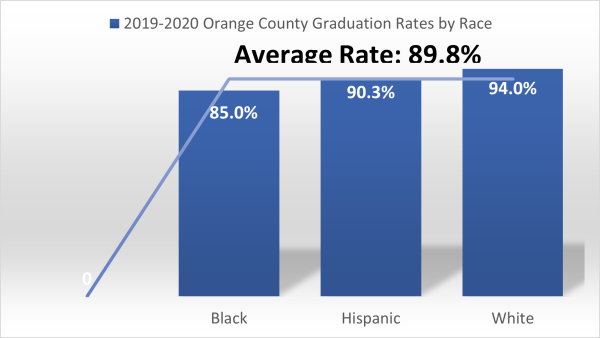
Addressing High School Graduation Rates in Orange County Public Schools
This post by Thrive Fellow Jasmine Haynes is related to the Thrive Education Impact Fund.
Recent data from the Florida Department of Education demonstrates that the state’s high school graduation rates have been steadily increasing. In the most recent data from 2019-2020, the state had a graduation rate of 90%, almost a 10 percent increase from the 2015-2016 academic year rate of 80.7%. Orange County Public Schools (OCPS) has also demonstrated steady improvement in overall graduation rates. For example, in the 2019-2020 academic year, OCPS observed a graduation rate of 90.4% compared to a graduation rate of 81.3% in 2015-2016. As reflected in Figure 1 below, OCPS’ graduation rates continue to exceed the state’s annual averages.
Figure 1
OCPS and Florida Graduation Rates

The GradNation Campaign formed by America’s Promise Alliance established a national goal to reach a high school graduation rate of 90% for all students by 2020 (America’s Promise Alliance, 2021). Although Florida and OCPS attained this established goal, the 90% rate is not reflected for every student demographic or subgroup. For instance, in the 2019-2020 academic year, White students reached a graduation rate of 94%, Hispanic students reached a rate of 90.3%, and Black students reached 85% (see Figure 2 below). While the GradNation Campaign’s goal was to achieve a 90% graduation rate for all students by 2020, this is a goal in which OCPS should continue to aim to meet for all student groups, especially Black students. If the existing disparities in graduation rates are not addressed, racially marginalized students will continue to be positioned behind their peers by not receiving equitable educational and economic opportunities (Martinez & Dorn, 2020).
Figure 2
OCPS 2019-2020 Graduation Rates Among Black, Hispanic, and White Students

Although school districts can integrate various strategies to try to eliminate disparities and improve graduation rates for all students, a critical approach is addressing school culture and climate. School culture describes the values, beliefs, and norms withheld in a school environment. In contrast, school climate describes how stakeholders (i.e., students, teachers, parents, etc.) perceive and respond to the school culture (Buckman et al., 2021). School climate is a factor that can influence how students engage with their learning environments.
According to OCPS school report cards, the district assesses students’, teachers’, and parents’ perceptions of school climate. Including measures of school climate in the district’s school report cards places the district at a great advantage to make progress in eliminating graduation rate disparities. The district should continue to assess school climate perceptions through surveys and consider gaining qualitative insight from students, teachers, and parents regarding school climate. Furthermore, the results and findings should inform practices and policies within schools and the district to increase high school graduation rates.
Overall, increases in high school graduation rates for the district are significant because high school graduation serves as a pathway for youth and young adults to be prepared for post-secondary opportunities. It is just as crucial that school leaders create a high-quality and equitable school culture that provides a socially, emotionally, and academically safe school climate for all students to thrive.
References
America’s Promise Alliance. (2021). GradNation. https://gradnation.americaspromise.org/
Buckman, D. G., Hand, N. W. J., & Johnson, A. (2021). Improving high school graduation through school climate. NASSP Bulletin, 105(1), 5-24. https://doi.org/10.1177%2F0192636521993212
Florida Department of Education. (n.d.). Florida’s federal graduation rates by race/ethnicity by school and district, 2019-2020. https://www.fldoe.org/core/fileparse.php/7584/urlt/FedGradRateRace1920.xls
Florida Department of Education. (n.d.). Historical graduation rates 1998-99 to 2019-20. https://www.fldoe.org/core/fileparse.php/7584/urlt/HistGradRateGraph1920.pdf
Martinez, D. G., & Dorn, S. (2020). Swamping errors: A Florida postmortem for high school graduation rate proxies. Voices of Reform, 3(1), 91-121. http://dx.doi.org/10.32623/3.00007
